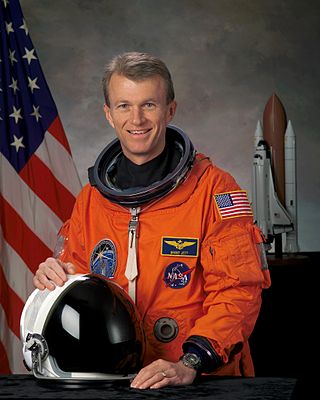
Jerome' "Jay" Apt III is an American astronaut and professor at Carnegie Mellon University. Before becoming an astronaut, Apt was a physicist who worked on the Pioneer Venus 1978 space probe project, and used visible light and infrared techniques to study the planets and moons of the solar system from ground-based observatories.

Kenneth Dwane "Sox" Bowersox is a United States Navy officer, and a former NASA astronaut. He is a veteran of five Space Shuttle launches and an extended stay aboard the International Space Station. When he launched on STS-73 at the age of 38 years and 11 months, he became the youngest person to command a Space Shuttle.

Jeffrey Shears Ashby is an American mechanical engineer, and former naval officer and aviator, test pilot and NASA astronaut, a veteran of three Space Shuttle missions. He is a retired Captain in the U.S. Navy. He currently works for Blue Origin as chief of mission assurance.

Kenneth Dale "Taco" Cockrell is a retired American astronaut, engineer and a veteran of five Space Shuttle missions. He served as Chief of the Astronaut Office from 1997 to 1998.

Richard Noel "Dick" Richards, , is a retired American naval officer and aviator, test pilot, chemical engineer, and a former NASA astronaut. He flew aboard four Space Shuttle missions in the 1980s and 1990s.

Curtis Lee "Curt" Brown Jr. is a former NASA astronaut and retired United States Air Force colonel.

Kent Vernon "Rommel" Rominger is an American former astronaut, former NASA Chief of the Astronaut Office at Johnson Space Center, and a captain in the United States Navy. Rominger holds the Space Shuttle Orbiter flight time record with 1610 hours. He joined ATK Launch Systems Group in 2006 as Vice President of Advanced Programs.

Andrew Michael "Andy" Allen is a retired American astronaut. A former Marine aviator and lieutenant colonel, he worked as a test pilot before joining NASA in 1987. He flew three Space Shuttle missions before retiring in 1997.

Stanley David Griggs was a United States Navy officer and a NASA astronaut. He is credited with conducting the first unscheduled extra-vehicular activity of the space program during Space Shuttle mission STS-51-D. Griggs was killed when the vintage World War II-era training aircraft he was piloting – a North American AT-6D – crashed near Earle, Arkansas.

John Elmer Blaha is a retired United States Air Force colonel and a former NASA astronaut. He is a veteran of five space missions aboard the Space Shuttle and Mir.

Michael Allen Baker is a retired captain in the United States Navy, former NASA astronaut, and the International Space Station Program Manager for International and Crew Operations, at NASA's Johnson Space Center. He is responsible for the coordination of program operations, integration and flight crew training and support activities with the International Partners.

Robert Donald Cabana is the Associate Administrator of the National Aeronautics and Space Administration (NASA), a NASA astronaut, and a veteran of four Space Shuttle flights. He served as Chief of the Astronaut Office from 1994 to 1997 and as director of the John F. Kennedy Space Center from 2008 to 2021. He is also a former naval flight officer and naval aviator in the United States Marine Corps.

Brian Duffy is a retired U.S. Air Force colonel and a former NASA astronaut. He flew aboard four Space Shuttle missions.

Terence Thomas "Tom" Henricks is a retired colonel in the United States Air Force and a former NASA astronaut. He served on four Space Shuttle missions.

Brent Ward Jett Jr., , is a retired American naval officer and aviator, test pilot, aerospace and aeronautical engineer, and NASA astronaut.

Donald Ray McMonagle is a former astronaut and a veteran of three shuttle flights. He became the Manager, Launch Integration, at the Kennedy Space Center, Florida, on August 15, 1997. In this capacity he was responsible for final shuttle preparation, launch execution, and return of the orbiter to KSC following landings at any other location. He was chair of the Mission Management Team, and was the final authority for launch decision.

William Francis Readdy is a former Associate Administrator of the Office of Space Flight, at NASA Headquarters.

Pierre Joseph Thuot is a retired United States Navy captain and NASA astronaut. He went into space three times, spending over 650 hours in space, including over 15 hours in three space walks. He is a former U.S. record holder for time spent on one spacewalk, and participated in the first three-person spacewalk.

Gregory Carl "Ray J" Johnson, , is a retired American naval officer and naval aviator, test pilot, aerospace engineer, and NASA astronaut. He spent his military career in both the regular United States Navy and the Navy Reserve. Johnson was the pilot on Space Shuttle mission STS-125, the final Hubble Space Telescope servicing mission.

Kenneth Stanley Reightler Jr. is a former NASA astronaut.




















